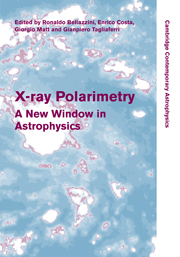Book contents
- Frontmatter
- Contents
- List of contributors
- Preface
- 1 X-ray polarimetry: historical remarks and other considerations
- Part I Polarimetry techniques
- Part II Polarized emission in X-ray sources
- 14 Probing strong gravity effects with X-ray polarimetry
- 15 X-ray polarization from black holes in the thermal state
- 16 Strong-gravity effects acting on polarization from orbiting spots
- 17 Polarization of thermal emission from accreting black holes
- 18 X-ray polarimetry and radio-quiet AGN
- 19 The soft X-ray polarization in obscured AGN
- 20 The polarization of complex X-ray sources
- 21 Polarization of Compton X-rays from jets in AGN
- 22 Polarization of X-ray lines from galaxy clusters and elliptical galaxies
- 23 Polarization characteristics of rotation-powered pulsars
- 24 Polarized X-rays from magnetized neutron stars
- 25 Polarization properties of X-ray millisecond pulsars
- 26 X-ray polarization signatures of neutron stars
- 27 Polarization from the oscillating magnetized accretion torus
- 28 X-ray polarization from accreting white dwarfs and associated systems
- 29 Polarization of pulsar wind nebulae
- 30 X-ray polarization of gamma-ray bursts
- 31 Central engine afterglow from GRBs and the polarization signature
- 32 GRB afterglow polarimetry past, present and future
- 33 Gamma-ray polarimetry with SPI
- 34 INTEGRAL/IBIS observations of the Crab nebula and GRB 041219A polarization
- 35 Fermi results on the origin of high-energy emission in pulsars
- 36 Diagnostics of the evolution of spiral galaxies in a cluster environment
- Part III Future missions
- Author index
- Subject index
15 - X-ray polarization from black holes in the thermal state
from Part II - Polarized emission in X-ray sources
Published online by Cambridge University Press: 06 July 2010
- Frontmatter
- Contents
- List of contributors
- Preface
- 1 X-ray polarimetry: historical remarks and other considerations
- Part I Polarimetry techniques
- Part II Polarized emission in X-ray sources
- 14 Probing strong gravity effects with X-ray polarimetry
- 15 X-ray polarization from black holes in the thermal state
- 16 Strong-gravity effects acting on polarization from orbiting spots
- 17 Polarization of thermal emission from accreting black holes
- 18 X-ray polarimetry and radio-quiet AGN
- 19 The soft X-ray polarization in obscured AGN
- 20 The polarization of complex X-ray sources
- 21 Polarization of Compton X-rays from jets in AGN
- 22 Polarization of X-ray lines from galaxy clusters and elliptical galaxies
- 23 Polarization characteristics of rotation-powered pulsars
- 24 Polarized X-rays from magnetized neutron stars
- 25 Polarization properties of X-ray millisecond pulsars
- 26 X-ray polarization signatures of neutron stars
- 27 Polarization from the oscillating magnetized accretion torus
- 28 X-ray polarization from accreting white dwarfs and associated systems
- 29 Polarization of pulsar wind nebulae
- 30 X-ray polarization of gamma-ray bursts
- 31 Central engine afterglow from GRBs and the polarization signature
- 32 GRB afterglow polarimetry past, present and future
- 33 Gamma-ray polarimetry with SPI
- 34 INTEGRAL/IBIS observations of the Crab nebula and GRB 041219A polarization
- 35 Fermi results on the origin of high-energy emission in pulsars
- 36 Diagnostics of the evolution of spiral galaxies in a cluster environment
- Part III Future missions
- Author index
- Subject index
Summary
We present new calculations of X-ray polarization from black hole accretion disks in the thermally dominated state, using a Monte-Carlo ray-tracing code in full general relativity. In contrast to many previously published studies, our approach allows us to include returning radiation that is deflected by the strong-field gravity of the BH and scatters off the disk before reaching a distant observer. Although carrying a relatively small fraction of the total observed flux, the scattered radiation tends to be highly polarized and in a direction perpendicular to the direct radiation. We show how these new features of the polarization spectra may be developed into a powerful tool for measuring black hole spin and probing the gas flow in the innermost disk.
Introduction
A recent flurry of new mission proposals has renewed interest in X-ray polarization from a variety of astrophysical sources, hopefully marking the “coming of age of X-ray polarimetry” in the very near future. The Gravity and Extreme Magnetism SMEX (GEMS) mission, for example, should be able to detect a degree of polarization δ < 1% for a flux of a few mCrab (e.g. and these proceedings). A similar detector for the International X-ray Observatory (IXO) could achieve sensitivity roughly 10× greater (δ <0.1%, Alessandro Brez in these proceedings). In this talk, based on our recent paper, we focus on the polarization signal from accreting stellar-mass black holes (BHs) in the thermal state, which are characterized by a broad-band spectrum peaking around 1 keV.
- Type
- Chapter
- Information
- X-ray PolarimetryA New Window in Astrophysics, pp. 103 - 108Publisher: Cambridge University PressPrint publication year: 2010
- 1
- Cited by

